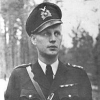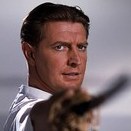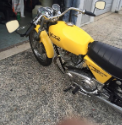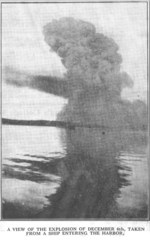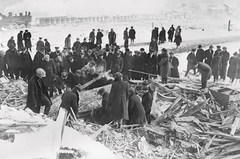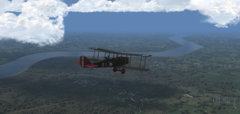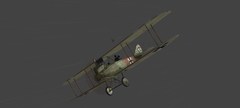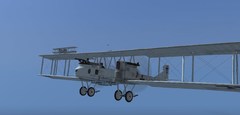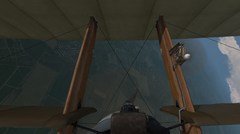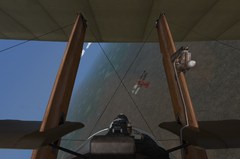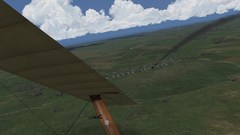-
Posts
147 -
Joined
-
Last visited
-
Days Won
1
Raine last won the day on October 11 2023
Raine had the most liked content!
Recent Profile Visitors
Raine's Achievements
Newbie (1/14)
102
Reputation
-
Further to the response by VonS, the developers are working on a further updated version to be released probably late this year (my guess only). Included in the many new features is this: "...more choice as to the brightness of the terrain and scenery render, as well as improved shadow render distance." When I moved over to Woff from ROF back around 2015, the muted colour palette was noticeable for a few days. After that, I never thought of it again. I also never went back from Woff due to its unparalleled immersion and AI.
-
Pol, Thank you so much for your quick research. I had bumped into a couple of the controllers in your links but not all of them. I'm looking for something that does not require much finger dexterity as well as something (as you suggested) that takes minimum force. Fortunately, one of the doctors I am dealing with is an ALS/MND specialist with a worldwide reputation. She has a multidisciplinary team in Fredericton, New Brunswick that I check in with monthly. They have two people who work full-time on adaptive technologies and they have a special interest in customising game controllers. I will be looking to meet with them and to see what they may be able to do for flight simulators. I'll keep my fingers crossed. Well, actually I can't do that these days. One way or the other, I'll try to get back into WOFF and WOTR! I'll lift a pint to you (or at least sip it through a straw)!
-
Sadly, I have to accept my forced retirement from flying WOFF. Four years ago I was diagnosed with motor neuron disease (ALS) and it has finally caught up. Just after New Year's I developed a very serious case of pneumonia and spent a month in the hospital. Since getting home three weeks ago, I have found that my hands are much worse. I have been putting off getting back into the DID campaign because I was frankly afraid of testing my ability to manipulate the controls. Today was the day. I was most afraid of finding myself unable to push the joystick to the right because the wrist lacked strength. That wasn't the problem. Getting to the keyboard buttons for engine start and map was a two-handed job. Controlling the rotating knob on my throttle that governed mixture was nearly impossible. I couldn't depress the button on my joystick that turned the automatic pilot on and off. Every time I needed two hands for one controller, the other one demanded the same two hands. I am going to lurk around the forum and contribute when I can, but I will have to pack Douglas Bell-Gordon, my campaign pilot, off to a staff job in England. The original plans were to have him stay with Naval Nine until after 1 April 1918, then command an RAF squadron until the end of the war. Fingers were crossed that after the Belgian expansion, we might see a Dolphin before November rolls around. Please let me take this opportunity to thank each and every member of this kind, friendly, mature, and respectful community. You have made this a wonderful pastime and passion. Special thanks and admiration go out to the development team. You have created a true time machine to make boyhood fantasies come true. Massive respect! Cheers, Raine
- 10 replies
-
- 13
-

-

-

-

-
"Curiouser and curiouser," said Alice…
-
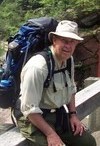
DiD IV Campaign - Flight reports & Player instructions
Raine replied to epower's topic in WOFF BH&H2 - General Discussion
That Journal of FCdr Douglas Bell-Gordon, DSC 9 Squadron, RNAS Part 26 18 November 1917. On board SS Middleham Castle. Third day at sea. The seasickness caught me by surprise – didn’t expect to be so vulnerable after my flying experience. Looking out over the rail of the Middleham Castle, I counted eight vessels on the port side. This was a small convoy, just over a dozen ships in all. In the distance brownish-black smoke curled away from an escorting destroyer. I gazed down into the grey waters folding and falling in icy rhythm. What lay beneath? We had seen dolphins earlier. Below here was the realm of sharks and cod. Sharks eating cod. The story of nature – the big fish eat the small fish. It’s all very simple. Then along comes man and their collaboration. Now the little fish work together and build weapons to attack the big fish. No more random, simple predation. Now we have proper wars, the ultimate product of civilisation. But why should we evolve into warmaking creatures? I thought about this for several minutes. Perhaps in the end it’s all mathematically the same. Millions would die anyway with predators thinning out the race of men one at a time. Thanks to collaboration, however, we now get the job done in a few years and then with luck enjoy brief periods of peace before the next thinning-out. In the brief periods of peace we can get on with the job of improving our lot. That’s the evolutionary benefit. Thus pleased with my reasoning, I threw up my breakfast. 4 December 1917. Halifax, Nova Scotia, Canada. Where to begin? The ship reached Halifax early – 24 November. That morning I went on deck and saw the shore of Nova Scotia emerging from the mist, all granite and windblown pine. We passed Sambro Head a couple of hours later and steamed at slow speed to give time for the Navy to open the harbour booms. Point Pleasant Park slipped past on the port side. I’d spent many a happy hour as a boy playing Rob Roy MacGregor in the woods there. Now released from convoy stations, each ship paused at the Examination Anchorage off McNab’s Island to be cleared into the harbour. The war had changed Halifax. British destroyers and Canadian patrol vessels cluttered the harbour, plus the at least one American vessel laid at anchor. It struck me odd how nearly all the city buildings were wooden. I suppose this had always been the case, but I was not used to it any more. The Citadel still stood watch over the harbour. The Middleham Castle was guided into Pier 2. This was in normal times the immigration terminal. These days it was mainly used as an embarkation point for troopships. Our ship was destined for repairs in the nearby drydock. Pier 2 was where I got off. Paperwork in the terminal took only a few minutes. From there I crossed the railroad tracks to the harbourside road and looked for a taxi. I had wired my parents from Liverpool and told them to expect me on the 25th at the earliest, so no one was here to meet me. So onto my shoulder with the duffle bag and on up the never-ending hill, following Cornwallis Street to the North Commons, thence across the windswept open Commons to the intersection known as the Willow Tree. I stopped for a coffee at a small café on Quinpool Road. It was getting late in the afternoon and the sun was down over the rooftops. Time to get home. I made my way past several streets to Jubilee Road. At the corner I saw my home – it was one of the few red brick places around, a compact two-storey detached house with a bow window. I crossed the street and began imagining what I would say to my mother. Just then came a stentorian bellow: “Stand fast, young man!” And down the street from behind me strode my father. He looked like the same strapping fellow I’d always admired, tall and broad-shouldered with a full moustache. He wore his favourite grey overcoat and bowler hat and carried a fine walking stick. Only I knew the weight of the ornamental brass knob at the end of the stick. Pop was a police detective and never left home without some means to take down the meanest thug in Halifax. The reunion was joyous. Mum cried for a good half hour and Pop went to the cellar to retrieve a bottle of whisky. Halifax had come under the Temperance Act after I left for England and was now a dry city. You could make booze and export it, but you couldn’t own it, drink it, or transport it for any reason except lawful export. Veteran policeman, however, might occasionally acquire a cheeky bottle or two for medicinal purposes. I was plied with questions about flying and about the front. Quite to my surprise I answered honestly and did not try to paint an overly rosy picture. Inevitably, Pop asked me if I had fought any German aircraft. I told him that I had been officially credited with the destruction of twenty-three Huns. A very long silence followed and Mum stared at me as though I was a stranger. Pop poured me a long drink. Then he did the same for himself. The next week and a half were spent visiting neighbours, schoolteachers, and the odd chum who was still in town. My sister Maggie was away, headed for England with the Red Cross. We wrote a “family letter” to her. One day, Pop took me to lunch at the Busy Bee Café on Barrington Street with a friend of his who was influential in the Dominion Police. He was angling for me to join that force after the war. The Dominion Police are a federal force. They do a lot of work avoiding smuggling, not the most interesting subject. But they have some responsibility for national counterintelligence work. That could be of interest. Still, my mind was not ready to grapple with thoughts of a peacetime career. 8 December 1917. Halifax, Nova Scotia, Canada. Everything has changed. Everything. I slept late on the morning of 6 December. Pop left for work long before. I went downstairs in my pyjamas and slippers and enjoyed a cup of tea and some toast while chatting with Mum. She was telling me about Gail, a neighbour from down the road who was expecting her fourth child. Mum was laughing as she related how Gail’s oldest girl was upset at the thought of a new sibling. Then the house shook violently. I heard window glass shattering upstairs and three of Mum’s precious china plates fell from a plate rail in the dining room. A deafening roar – louder than anything I’d heard in France. We both dived under the table and waited while the house continued to shake and rattle. Then I ran outside. Jubilee Road seemed normal at first. Then I saw that two trees were down farther up the road towards Robie Street. On many of the houses all the windows were smashed. Somewhat more sheltered, our house had lost only the upper windows at the front. Across the street and farther up, the roof of one house laid shattered on the pavement in front. A greasy, charcoal-coloured cloud rose above the rooftops. I heard my mother gasping. “Oh dear Lord, what is happening?” “No idea,” I said. “Are the Germans here?” I shook my head. “They have nothing like this. Maybe it’s a magazine explosion. I need to find out and see if they need help. I’m going to get dressed. Can you check on the neighbours?” Already we could hear the sound of children screaming and women crying. Minutes later I was in my work dress uniform and watch coat, striding up to Robie Street. The thick, roiling cloud rose a mile over the city. At first the damage seemed scattered. There was a piece of jagged metal lying in front of one of the houses on our street. A wagon lay on its side on Robie Street, the horse kicking and screaming in panic. I crossed over to the North Commons. Nearly half of the temporary barracks buildings there were damaged or destroyed. The sandstone Armoury still stood guard across the field. Its semicircular window over the doors was mostly gone. I headed diagonally across the Commons to the end of Agricola Street. Here the telephone poles were fallen and wires draped everywhere. In places entire houses had collapsed. There were screams and shouts. Already teams of militia soldiers frantically searched for survivors. I spotted an officer and asked him what had happened. “Not sure, really,” he said. “There are rumours of a munitions ship going up. Then again, a fellow just told me there was a Zeppelin over Dartmouth.” I knew this was impossible but said nothing. A voice cried out from the rubble behind us. The officer directed two men to follow me and the three of us dug through splintered wood and bits of plaster until we found an elderly man pinned under a roof beam. His face was torn with bits of broken glass and I could not make out his eyes. We got him out and carried him to the side of the road. Someone brought a blanket. Men were working with shovels and axes to clear an open lane for wagons or lorries. Already one could smell smoke and see flames here and there in the wreckage where stoves and coal fires had been upset. I worked the entire morning along that street, all the time thinking that I should report to the Navy. At noon a lieutenant told me that I could get tea and a sandwich back at the Armoury. Instead I continued walking along Agricola, arriving at North Street, where I turned down the hill toward the harbour. The North Street train station was a ruin. The glass roof had fallen in and the walls were down in places. The closer I got to the harbour more total the devastation became. At Barrington Street I met a petty officer who had some information. It seems that a French munitions ship collided with another vessel bringing relief supplies to Belgium. This happened at the Narrows, which as the name implies is the narrowest part of the harbour, coming just before the end of the harbour opens into a broad bay called Bedford Basin. The Basin is where convoys formed up. Anyway, when the vessels collided the French ship caught fire. Then the whole place went up. According to the petty officer, the entire north end of the city is destroyed. He pointed to Wellington Barracks, just visible through the broken trees from where we stood. The small magazine next to the barracks had caught fire after the blast, but soldiers had worked to get it under control. “A lot of folks started to panic that there was going to be another explosion,” the petty officer said. “We’re going to have a job keeping people from going nuts with rumours.” He had not exaggerated about the north end being levelled. By the time I got to Barrington Street, it was clear how very dire the situation was. This part of the city had simply ceased to exist. I was reminded of Ypres. Except that at Ypres the rubble was brick and stone. Here there was only shattered lumber and a few stumps of chimneys. Street after street were erased. Close to the harbour the sugar mill and brewery had collapsed and train carriages lay on their sides. The Belgian Relief ship, badly damaged, lay against the far shore. Ships at the naval dockyard showed signs of damage. My old ship, the Middleham Castle, was now berthed near the drydock. Its funnel hung over at a sharp angle. I later heard that the ship’s third engineer had been blown from its decks and landed naked at Fort Needham, nearly two miles away! I went to the dockyard and reported to the old cruiser HMCS Niobe, which acted these days as the headquarters for the Royal Canadian Navy. There a British senior officer assigned me to lead a rescue team of ratings. We had a wagon to transport the injured to the dockyard. All the hospitals were filling up and one of the American ships in the harbour had been quickly converted to a hospital vessel. Before setting off, I enquired about my return to France. Originally I was set to return on the same ship I arrived in, but it was clear that the Middleham Castle was not leaving Halifax any time soon. They told me they would try to get me back on a convoy but for the time being I was a rescue worker. Militia soldiers searching the ruins – 7 December 1917 Ruins of Richmond, looking toward the Narrows 11 December 1917. Aboard HMS Highflyer. There is no need to write down everything I did in the next few days. Those memories are burned into my brain for life. That first day we worked our way north towards the Basin. Crews cleared a single lane along Barrington Street. We left the dead alongside the street and loaded the injured on our wagon. That afternoon we collected more than two dozen women and children who were blinded. They had been watching the fires on the Mont Blanc, the munitions ship, and the Imo, the Belgian Relief ship. Windows shattered in their faces as their houses collapsed around them. We were directed to send all the poor blinded victims to Camp Hill Hospital. I returned home very late that evening to find that my mother had opened our house to our expectant neighbour Gail and her children, as well as two other local families whose houses were no longer safe. We were lucky. Our street was partially sheltered from the blast by Citadel Hill and the slightly higher ground at the North Commons. Pop sent a message that he would likely not be home for a few days. Prime Minister Borden was coming to town and Pop was preparing for meetings at City Hall, where they would be setting up committees and emergency relief organisations. The following day, 7 December, was marked by a blizzard. Six inches of snow fell over the ruined city. We continued the grisly task of digging through the wreckage looking for survivors. The first relief trains arrived that day, to be followed by many more from Montreal and Boston especially. Public buildings and halls were converted into makeshift hospitals. More than 300 doctors and nurses arrived from other parts of the Maritimes, with hundreds more coming from the United States and the rest of Canada. As the morgues of the city were overwhelmed within hours, orders were given to bring the dead to the basement of Chebucto Road School. Our work was occasionally hindered by crowds of onlookers. Police Chief Hanrahan stopped that by issuing passes to all those authorised to be in the “devastated area.” Three more days of mind-searing rescue work followed, with fewer and fewer survivors coming out of the ruins. On 9 December I returned to Niobe to enquire about my return to France. After a couple of fruitless hours being bounced from one officer to another, I finally discovered someone who was aware of my existence. My travel documents were already prepared. I was ordered to board the British light cruiser HMS Highflyer the following evening. Highflyer was to escort the first convoy out of Halifax. On 10 December, Pop returned home for the first time since the explosion. He had a bath and a drink and then we all had tea together. No taxis were running, so he arranged for a police vehicle to drive me down to Bedford Basin to board the ship’s boat. We put to sea early the next morning, slipping in single file through the Narrows. We passed the wreck of the Imo along the Dartmouth shore. I asked about the Mont Blanc. It had simply ceased to exist. We passed McNab’s Island and proceeded at dead slow while the thirty-four ships of the convoy sorted themselves into rows and columns as they headed to the open ocean. We were bound for Plymouth. that The Imo after the blast Barrington Street YMCA, converted to a temporary hospital Notes The Halifax Explosion of 6 December 1917 was the largest man-made explosion before the atomic era. It was triggered by a series of errors resulting in the Imo entering the narrows on the wrong side of the harbour. The Mont Blanc sounded its horn and held course. Although the ships collided at slow speed, the results were devastating. The Mont Blanc carried a cargo of high explosives, including TNT and picric acid. Its deck cargo included barrels of highly volatile benzol. The collision ignited the benzol on deck. The ship burned and drifted toward the north end district of Halifax known as Richmond, where it went aground. At 9:04 AM, the burning benzol found its way below decks to the main cargo. The blast wave flattened the north end of the city and caused damage across a wider radius. The explosion also caused a tsunami up to 60 feet above normal sea level as the blast laid bare the harbour floor and the water crashed back to fill the void. The explosion and tsunami killed nearly 2000 residents. 9000 were injured, many of whom had been watching the fire on the Mont Blanc through their windows and who were completely or partially blinded by the storm of glass fragments when the blast wave hit. About 6000 Haligonians were left homeless. As a reminder of the strength of the blast, the shaft of one of the Mont Blanc’s anchors landed across the Northwest Arm about two and a half miles from the site of the collision. The shaft, weighing more than a thousand pounds, had flown over the entire city and the waters of the Arm before landing there. It is today mounted in a small park near where it landed. Amidst the horrors of the tragedy lies a more positive tale. The heroic relief efforts in the wake of the explosion were a lesson for future generations. Overnight, public spaces were turned into hospitals. Trainloads of medical personnel and supplies arrived from across Canada and the US. Innovations in ophthalmic surgery, emergency and rehabilitative medicine, prosthetic design, and emergency response organisation followed. Canadian and British governments donated millions for reconstruction. The explosion was a major factor in the establishment of the Canadian National Institute for the Blind. The CNIB is still a major charitable institution providing service and support for persons with visual disabilities. Incredibly, as Douglas’s story illustrates, the port of Halifax was able to resume its wartime duties within less than a week of the explosion. As a final footnote, the province of Nova Scotia sends a giant Christmas tree to the city of Boston each year as a token of gratitude to the residents of that city for the support provided to Halifax in the wake of the 1917 disaster. -
-

DiD IV Campaign - Flight reports & Player instructions
Raine replied to epower's topic in WOFF BH&H2 - General Discussion
Rick, good to see you here! I'm enjoying your video series. Journal of FCdr Douglas Bell-Gordon, DSC 9 Squadron, RNAS Part 25 16 March 1917. On board SS Middleham Castle. "From there it was a simple matter of staying above the barrage balloons…" Had a bit of excitement on 4 November – led a defensive patrol down to Bailleul, providing protection for the several aerodromes in that sector. We had scarcely arrived when a cluster of white-grey Archie bursts drew our attention to a lone Hun two-seater about a mile and a half off to the south. I waggled my wings and led the flight to cut off the Hun’s retreat. The EA was a new type with a biplane tail. My first burst from behind and below sent the fellow into a steep spiral dive. Edwards and I followed him down firing all the way, until I caught him pulling out around 8000 feet. One last push of the trigger levers sent at least fifty rounds into the cockpit area, and the Hun fell vertically, streaming smoke. It fell a couple of miles south of Arras, my twenty third official victory. Over the next several days we typically flew only one patrol a day. We chased away some Albatri one afternoon, and on another day harried a Rumpler. Nothing conclusive – just longer and colder patrols. Meanwhile, the big push at the salient drew to a conclusion. The Canadians took their objectives on the final ridge. On the larger stage the situation in Russia seems out of control and we are worried that the Ruskies will pack it in and leave the Germans to us in the West. Just what we need, I think not! By 10 November, the whole of our sector from Diksmuide to the coast was quiet, the Huns having gone into hibernation for the winter. On 15 November, I completed the early patrol. We enjoyed a touch of excitement when we ran into a group of Pfalz scouts. They put up the briefest of fights and then ran away before anything of significance happened. The Pfalz machines dive like gannets. The squadron commander sent for me as soon as I’d completed my report. “Your Canada leave has come through, Douglas,” he said. “But the last ship I can get you on that will have you in Canada before Christmas sales from Liverpool at nine this evening, our time.” The clock on the office mantle told me it was eight-thirty. Squadron Commander Norton gave me the use of a driver and his car to get me to Naval Five at Petite-Synthe. They had a worn out DH4 that needed to go back to England. I was to pick up Shaw from 5(N) Squadron and fly to a place called Hooton Park. This is an RFC aerodrome not far from Liverpool. Arrangements had been made for Shaw to spend the night with the RFC training establishment there and return the aircraft to Eastchurch in the morning. It was hoped that I could get a drive into Liverpool or at least a taxi. Then there was the matter of the ship. No troop ships or passenger ships were Halifax bound for a week or more, so I had been booked on one of two open cabins on a cargo vessel – SS Middleham Castle. With luck I’d be home in a week and half. I threw my things together in minutes. There was a lace tablecloth I’d bought for Mum and a lovely French pipe for Pop. I’d not had a change to shop for Maggie, my sister. But I wasn’t even sure that she was in Halifax. Last I heard she was part of a Canadian Red Cross VAD contingent bound for England and perhaps France. Things would get sorted once I landed at home. The boys at Naval Five were a fine lot. Flight Sublieutenant Shaw introduced himself and invited me into the wardroom for a coffee laced with brandy and a bacon sandwich with brown sauce. We went over our maps together. The plan was to follow the coast to Calais and thence west northwest to Dover. We would skirt the west and north side of London and point ourselves in the general direction of Birmingham. This would be the hardest landmark to miss, and as our only map was a large railroad map of England and Wales, we could not afford to be overly detailed in our navigation. From Birmingham we would head northwest, hoping to meet the Mersey River somewhere between the ocean and Liverpool. We would then drop down and follow the coast to Hooton Park aerodrome. After a quick briefing on the DH4, we headed out to the sheds. Our machine was ready and nearly up to temperature. I climbed aboard and settled into the spacious cockpit. Wonderfully rugged, it seemed. This machine was powered by a 200 horsepower Royal Aircraft Factory engine. Most of the type enjoyed more powerful motors, so that is why our mount was being put out to pasture in England. We took off and turned over Dunkirk, following the coast. By the time we arrived at Calais we were already up to 8000 feet. Shaw’s voice came through the speaking tube, reminding me of the course to Dover. It was a sunny, cold morning with moderate gatherings of cumulus clouds from 7000 to 10,000 feet. We continue to climb clear of the cloud. After about twenty minutes I heard Shaw saying something I could not make out. I turned and saw him pointing downwards. Through a gap in the cloud one could see the white cliffs. Now we dropped down to around 6000 feet, all the better to navigate and a bit warmer. The Thames became visible ahead. I recognised the southward bend in the river east of Gravesend, and then the distinctive landmark of Tilbury docks. From there it was a simple matter of staying above the barrage balloons and following the indistinct edge of the metropolis north and then west until the straight line of ancient Watling Street stood out clearly. All praise to Emperor Claudius! This road became our guide all the way to Birmingham. Or at least I thought it was Birmingham. I began to set a course for the Mersey until I remembered that Coventry lay to the east of Birmingham. Sure enough, I picked out the famous cathedral below. Then the smoke haze of England’s second city became obvious, and I headed west until I was really over Birmingham. Now it was a simple matter of flying northwest to the Mersey. But of course, matters are seldom as simple as they should be. The cloud became heavier and we descended to around 4000 feet. There was a bit of ground haze, so it took me by surprise when a line of hills emerged just ahead on to our port side. I’d forgotten how hilly Wales was supposed to be. The railway map did not show hills and mountains. Besides, it was massive and if I pulled it out now it would be torn away in the slipstream. Another mountain appeared dead ahead. We climbed and followed a gap around the peak. Yet more mountains appeared. The compass was still moving about and I held the machine steady for several minutes. We were heading nearly directly west. This course would bring us into more high terrain and deposit us directly onto the Irish Sea. I decided to turn due north. About twenty minutes later I made out shoreline ahead. It was running roughly east and west. Must be the mouth of the Mersey. When we arrived over water I turned east. If this was the south shore of the Mersey, why could I not see the north shore? Now the shoreline turned southeast and a far shore appeared, but there was no sign of Liverpool. We were flying over a wide bay that soon began to narrow. I had no choice but to turn north-east and pick up the main coastline once more. My mistake became obvious in a few minutes. I had completely forgotten about how the River Dee joins the open water just below Liverpool. We had been heading up the wrong river. Soon the proper entrance to the Mersey appeared and we descended over its south bank, passing low over Birkenhead. The challenge now was to find the aerodrome. Finding aerodromes was an easy task in France where they stood out clearly in the flat farmland of Flanders and Picardy. The problem here was the sprawl of built-up areas. Every time I thought I’d spotted the place, it turned out to be a part or a football pitch. It was Shaw who drew my attention to Hooton Park. By the time I’d heard his call through the speaking tube, the aerodrome was over my left shoulder. The sheds were unusually dark and did not appear distinct. We turned back over a built-up area and began our descent. I arrived at the edge of the field much too high and much too fast. We went around again. On the second approach we were lower but still too fast. Feeling like a fool, I went around for a third time. I missed the ability to blip the engine! The damn DH simply would not slow down. This time I shuddered over the treetops onto the field at the edge of the stall. Even then, I used all the ground available to bring the machine to a stop. “You realise that will cost you a drink or two, don’t you?” Shaw said. A tender with two Ack Emmas pulled up and I asked the petty officer in charge to get the machine back to the sheds. I really didn’t want to see the bloody thing again, I explained. To my delight there was a Navy car waiting for me. “It is you!” the driver said. “Remember me, sir?” I studied the man’s face. Where had I seen him before? “Luxeuil, of course You were the chap that picked me up at the train station. My God! That was August of last year. What brings you back here?” Sure enough, my driver here was the same fellow who had brought me to 3 Wing on my arrival in France. I remembered that he was a Liverpudlian. The driver explained something about a medical issue and a doctor, but his accent had not become more decipherable in the past year. He waited while I spoke with the RFC station commander and thanked him for his patience with my landing and for hosting Shaw for the evening. I also left a few shillings to ensure that Shaw’s drinks were covered. From there I made a quick stop at the latrines and headed out to the car. It took a very long time to get to the docks where I finally boarded the SS Middleham Castle around four in the afternoon. I met the captain, Captain Irvine and the first officer, Mr Gwilliam, who showed me to my billet. The cabin was a spartan affair. An iron bed frame was bolted to the wall and topped with a thin mattress. The sheets and blankets were like the standard Navy issue. A bedside table held a shaded reading lamp. Its wooden base was screwed to the tabletop. There was no closet for clothes, merely a couple of open shelves and a row of three hooks. The nearest toilet and bath were at the far end of the passageway outside. I had a chair but no writing table. Fortunately, Mr Gwilliam showed me to what he described as the ship’s library. This was a room of modest proportion with three wooden card tables and a collection of chairs, including two comfortable armchairs. There was a bookshelf with an odd assortment of novels and maritime-themed non-fiction works. They had today’s Daily Post and a collection of magazines. I settled into an armchair and pulled over a standing ashtray. After a quick smoke and read, I fell sound asleep. -

DiD IV Campaign - Flight reports & Player instructions
Raine replied to epower's topic in WOFF BH&H2 - General Discussion
Journal of FCdr Douglas Bell-Gordon, DSC 9 Squadron, RNAS Part 24 3 November 1917. Bray Dunes, France. "The Hun began to fall and just then Redgate’s Camel came between me and it." As October progressed, the enemy became ever more bothersome in our sector. They preferred to fight us over their own side of the lines by day, but by night they would send raiders to attack our aerodromes. The fields around Bray Dunes were hit frequently around this time. We dug slit trenches outside our cabins. These we improved over time by adding more sandbag protection and deep dugouts with overhead cover. Some of the fellows, perhaps most of them, have begun sleeping in those dugouts. For my own part I prefer the warmth of my cot to the safety of our dugout. Still, every few nights the Huns leave us with cratered fields and occasionally with a burning shed or building. Our French neighbours have lost their other ranks’ mess and the nearby Belgian squadrons have had a number of machines destroyed. On 15 October, the Huns came over shortly after nine in the morning. I was one of several pilots who were hanging about the sheds and therefore able to get airborne at the first alert. Without waiting for the others I climbed away sharply as soon as the wheels left the ground. Grey puffs from friendly Archie showed the way. About a half-dozen enemy two-seaters were lazily circling above Bray Dunes, taking turns lining up on the rows of hangars below. It took me a while to reach them. They were up around 10,000 feet. I selected one machine that stood slightly farther from the others and began to stalk it. Unfortunately, the other EAs spotted me and fired from long range, alerting my prey. The Hun – it was a Rumpler – got the wind up and turned for home. This move necessitated a dangerous pursuit, one in which I could close the range only slowly. As much as I attempted to stay in the enemy’s blind spot, his gunner was periodically able to fire bursts in my general direction. This reminded me how much I disliked attacking two-seaters by myself. I held fire until I was about 200 yards behind and just below the Rumpler. My first burst scored some hits and the enemy pilot seemed rather disconcerted. He threw his machine into a downward right-hand spiral. This was lovely for two reasons. First, it forced the enemy observer/gunlayer to abandon his weapon in favour of holding on for dear life. And second, it allowed me to attack the Hun machine from above. The Rumpler has always seemed more fragile than the other larger enemy machines. This time was no exception. I fired a burst of ten or fifteen rounds from each Vickers and saw pieces of the upper wing fall away. The Hun began to fall and just then Redgate’s Camel came between me and it. I banked into a near-vertical dive and flashed past Redgate to finish off the Hun with one last burst. The Rumpler fell about four miles north-east of Bray Dunes. When I landed, several of the lads went with the squadron commander’s car to find the wreckage. I wasn’t up for the trip, so I asked them to get a piece of fabric for the wardroom wall. The Rumpler brought my account up to 22 confirmed victories, one more than my old pal Huntington had claimed, only my score and lacked his degree of imagination. We flew offensive patrols for the next few days, most of which were uneventful. We had a good scrap with some Albatri on 18 October and I sent one down in a spin but could not see whether it recovered. On 20 October, however, things were more eventful. That day we conducted a close offensive patrol. This sort of patrol keeps close to the front and just behind the enemy lines. It was towards the end of our time and we were re-crossing the lines when we encountered three Hun two-seaters heading east. I immediately attacked one of the two machines at the rear of their little formation but was driven away by an energetic and accurate gunlayer. Brown led two of his boys against the fellow. They seemed to do no damage. I had regained altitude and was trying a beam attack when the enemy gunner swung his weapon about and caught me with his welcoming burst. One round smashed into my left Vickers and a piece of metal – I’m not sure whether it was part of the round or part of my machine-gun – sliced open my left jaw. It bled horribly and I confess that I was awfully upset at the thought that it had terribly disfigured me. I landed at the field near Nieuport and was carted off to a French casualty clearing station. From there I was taken to the Queen Alexandra Hospital at Dunkirk. It turned out that the injury was not at all serious and would leave only a rather dashing thin scar. It provided me with a week’s rest at a time when it was most welcome. I had a number of visitors during my stay, many of my chums from Naval Nine and several from other nearby squadrons. Greaves from 12 Squadron dropped by and we spent a pleasant couple of hours. I’d met him only once during my training and once as a guest at Leffrinckoucke. His sister was a VAD here at the hospital. I returned to duty on 28 October and led a defensive patrol down to Bailleul. On our return, we explored a bit of the front at the salient. The fighting near Ypres has gone on since the summer. The place is a perfect vision of hell. For miles around nothing recognisable remains. Roads are drowned in mud. Former villages are marked only by a more reddish taint of mud. Shell hole abuts shell hole, and all are filled with vile green sludge. The constant explosions and occasional gun flashes betray the presence of men, but the men and the mud are indistinguishable one from the other. The Anzacs have given the enemy a good going over. The ridge near the smashed village of Passchendaele remains to be conquered before winter comes, and the Canadian Corps has been moved into the sector to do the job. You can be proud to be Canadian these days. Our boys did a splendid job at the end of the summer down near Lens and, on top of the Vimy Ridge fight in the spring, are making quite the reputation for themselves. Perhaps I have that reputation to thank for the conversation I had this afternoon with Squadron Commander Norton. He has informed me that I am to be awarded the Distinguished Service Cross for success in air fighting. It will be gazetted later this week, but I was told to put up the ribbon right away. The greatest news, however, was that he has put my name forward for home leave. I can expect to get at least two or three weeks in Canada and should receive news of when I go before the end of November! As much as I am a terrible correspondent, I immediately wrote home to the parents and have begun to think about what I can bring as Christmas presents. I cannot lie to myself. The leave is most welcome. I feel very tired and for the first time have begun to worry about my nerves holding out. A little break from more and some peace and quiet back in Halifax will be most welcome. -

DiD IV Campaign - Flight reports & Player instructions
Raine replied to epower's topic in WOFF BH&H2 - General Discussion
Journal of FCdr Douglas Bell-Gordon, RNAS Part 23 14 October 1917. Bray Dunes, France. "At Ghistelles, I turned over the Hun sheds and let loose the bombs – two hangars went up in flames!" On Thursday, 27 September 1917, we moved yet again. This time our move took us a few miles farther east to an aerodrome called the “Middle” or “Frontier” aerodrome, just south of the community of Bray Dunes and very close to the border with Belgium. The new field was flat and expansive, and we shared it with several other British and French squadrons. The French occupied the more southern parts of the area while 9 and 3 Naval occupied the more northern parts along with a couple of RFC squadrons flying RE8 two-seaters. As can be imagined, the place was alive night and day with the sounds of aero engines, gramophones, laughter, annoyed petty officers, dogs, and French arguments. We settled in quickly. The wardroom played host to friends from nearly every squadron in the north. Squadron Commander Norton began to make his presence felt. He encouraged his flight commanders to study war flying as a trade. When the weather permitted, he hosted lunch for the flight commanders in his cabin. The topics were always the same – an overview of operations, equipment and tactics, personnel issues, and recommendations for improvements. He recognised that in the air service, the officer pilots had a life quite separate and apart from the lower decks. He worked it out with the Chiefs that each flight commander would be held personally responsible for the development and welfare of other ranks attached to their flight, provided that training, discipline, and development initiatives were to be coordinated with and administrated through the appropriate Chiefs and Petty Officers. He even set aside some non-public funds for use by the flight commanders for purposes beneficial to their men. We immediately set about procuring some battered hockey sticks (ice, not field) and turned the carpenters to the task of building rudimentary boards for an indoor “rink” that could be erected on the concrete floor of one of our oversized hangars. A tennis ball would substitute for the puck. It would be 9 Squadron versus 3 Squadron on a date to be determined. October began with a series of mostly inconclusive engagements between our Camels and Albatros scouts. We learned to recognise the German Navy aircraft by their distinctive black-and-white stripes, and a fierce rivalry sprung up. Banbury claimed the first Hun shot down since our recent move. On 4 October, I led B Flight to drop bombs on the enemy airfield at Ghistelles. As soon as we had formed up, we headed north over the sea and then turn east toward Ostend. From Ostend to the target was one long, shallow dive. At Ghistelles, I turned over the Hun sheds and let loose the bombs – two hangars went up in flames! Now it was time to pull up and away, but as I did so I spotted a purple and green two-seater taking off from the field below. I kicked the rudder over and dived on it when it was still barely a hundred feet up. My rounds splattered across both upper wings and onto the cockpit area. The enemy machine rolled to the right and dived straight into the ground. Finally I had another confirmed victory. This success was followed on 10 October when our ship’s bell sounded the alarm in the late morning. We ran to our machines and took off as quickly as we could, for German bombing machines were in the area. Friendly AA fire alerted me to the presence of two Rumplers. One of the Huns turned to fight me while the other ran for home. I caught the aggressive fellow in a tight turn and saw his machine, powered in the air after a short burst at close range. There was still time to catch the second Hun before he made the lines. This one too fell out of control and crashed. I was credited with the first EA but was one of three Camel pilots firing at the second, so I withdrew my claim. We held the hockey match on the afternoon of 11 October. Mulock’s boys led off the scoring and were soon up 2-0. We had a strong contingent of French spectators from the two escadrilles across the fields. They interrupted the proceedings by presenting the Canadian team captains with bottles of apple brandy – potent stuff. It was announced that since the game was being played on French soil it had to be played by “French rules.” Any team who scored had to down a stiff belt of brandy, so double brandies were poured for the 3 Squadron side. This ingenious system evened the game wonderfully and we arrived at our designated break (we play two halves instead of three periods) tied four-all and pleasantly tight. The second half was a comedy act. Anderson from 3 Squadron was sick on the concrete floor, and our 9 Squadron side insisted this was because for a penalty shot. The matter was resolved amicably when our own man, Edwards, also was sick. By the time each side had reached seven goals the score was forgotten and most of the players simply sat down and held their heads while “Hugo”, a mongrel mix of mostly terrier extraction disgusted us by licking the floor clean. The French were highly entertained. Then on 12 October we flew a defensive patrol down toward Ypres. There we encountered a formation of DFWs and fell on them. I dived on one and saw the enemy pilot pitch forward in his seat. The machine began to tumble and fell from 8000 feet, landing just northwest of the stricken city. This was followed the next day by another DFW which I met over the lines whilst patrolling just across the river Yser. My first burst silenced the gunner and I closed to within twenty yards before administering the coup de grace. "I dived on one and saw the enemy pilot pitch forward in his seat." This brings my tally up to 21 confirmed. Time for a binge! -

Assist Request for Bombing/Radio/Camera missions
Raine replied to Grumman60's topic in WOFF BH&H2 - General Discussion
Look at the list of "sticky" threads on this forum. Pick the one entitled "BH & H II Version 1.21 Recon Wars – Notes". It has all the required directions. -
Grimsbergen. That is all.
-

DiD IV Campaign - Flight reports & Player instructions
Raine replied to epower's topic in WOFF BH&H2 - General Discussion
Journal of FCdr Douglas Bell-Gordon, RNAS Part 22 26 September 1917. Leffrinckoucke, France. "Large fragments of wood and fabric broke away. The Albatros nosed down out of control and began to tumble." The first few days at Leffrinckoucke were rainy and blustery, and we were grounded most of the time. I was able, however, to get in a few familiarisation flights. Moreover, I was able to spend the time necessary to get to know some of my fellow pilots, and especially those of my own B Flight. Naval Nine has not been a happy or a lucky squadron. It was drawn together from training establishments back in England. Operational experience was largely lacking. Our first squadron commander, Fawcett, struggled to bring the unit up to standard, either in the air or on the ground. By all accounts, we lacked aggression and seldom had all our aircraft in flying condition. Poor old Fawcett was returned to his unit and replaced by Squadron Commander Vernon. It was Vernon who welcomed me on arrival. He is relishing the prospect of turning the squadron into a crack team and has very clearly set out his expectations – lead by example, go after the Hun without hesitation, stay on top of aircraft maintenance for my flight, and remember to keep the squadron a happy place. Central to that last objective, the swarm of Chinese labourers working alongside the REs has erected four Nissen huts in as many days. I moved into one of these “cabins” together with A Flight commander Joe Fell and our Equipment Officer, Art McCready. The fourth in our little gang is “Boots” Le Boutellier. Boots is a Yank from New Jersey, but his mother is Canadian. If we count him in, that makes all four of us from Canada. Next door we have Stearne Edwards and Roy Brown, both from Carleton Place, Ontario. They are friends from back home. With them are two Englishmen, Oliver Redgate and Harold Stackard. On the other side of that cabin is one shared by Taylor from Ontario, and Banbury from Saskatchewan. Their cabin mates are Wood and Mellersh, both English. I’m still getting to know the others. Life here is kept exciting by regular visits from night Huns. About every other evening one or two enemy two-seaters drifts by to drop bombs on our aerodrome. And once or twice a week we are awakened by thunderous explosions from the Leugeboom gun. This is a fifteen-inch gun about twenty-five miles from here. It has been dropping rounds on Dunkirk, Malo, Coudekerque, and surroundings. Depending on the level of activity at the front, one can sometimes even hear the gun fire. It takes more than a minute and a half before each massive round smashes into Dunkirk! Our squadron commander, Vernon, did not last long. A couple of days after my arrival he went forward to check on a recovery team that was extricating a Camel from a shell crater close behind our lines. The Huns spotted the effort and shelled the site heavily, killing Vernon and wounding two fitters. Our new commander arrived the following afternoon. Squadron Commander Norton is a Welshman and seems like a force to be reckoned with. I’m sure he will pick up where Vernon left off. On 16 September, I finally got to lead B flight over the lines. Our sector is the northernmost part of the entire western front, stretching from Ypres north to the sea. In this sector the dikes have been broken so that the Yser River now spreads across a wide floodplain, turning the entire countryside into a muddy bog. This stalled the German advance along the coast. Here we have both Belgian and French troops in the front line, with British divisions holding the line south to Ypres. On this day we patrolled from Middelkerke to Cortemarck and encountered a formation of six or seven Albatros vee-strutters. I led our six Camels to the attack. The fight was brief and more than a little terrifying. Our fellows were new to this game and there were many near collisions. In the end, we drove the Huns off but were unable to claim any as destroyed or even out of control. Following several days of rain and high winds we attacked an enemy balloon near Eernegem. We succeeded in driving it down and causing it to smoke, although the thing couldn’t be claimed. On 21 September, we again patrolled behind the German lines. This time we chased a DFW and shot some pieces away. The fight, however, remained inconclusive. The following day we scrapped with a large group of Albatri over the front and I sent one down, apparently out of control. Unfortunately it fell into a large cloud bank and was not seen to crash. That night we hosted 5(N) Squadron in the wardroom, as well as several visitors from Naval Three. I knew some of the lads, either from training or from my time with Naval Eight – Le Mesurier, Jope, Clarke, and Omerod. The CO of Naval Three is a fellow Canadian, Mulock. First rate fellow. We have set up a baseball game between our squadrons and I have again been pressed to work as the umpire. 25 September was a banner day. Our patrol took us close to the Hun aerodrome at Ghistelles. There the Archie bracketed our formation with their first salvo. In the process of shaking off their aim, I failed to pay attention to a large group of Albatri approaching from the northeast. The AA fire suddenly ceased and we found ourselves with our hands truly full. These were the new Albatros scouts with the rounded fuselage. They seem only marginally quicker than the older types, and our Camels can easily outturn them. “Keep above the fight,” I told myself. I wanted to watch over the less experienced men. Stearne Edwards flashed past, close behind a Hun. A second Hun was turning onto his tail so I dropped in at the end of the procession. The pilot of the second Albatros was so focused on Edwards that I was able to close to within twenty yards before firing. The twin Vickers guns rattled and I saw my rounds strike the fuselage and left wings of the enemy machine. Large fragments of wood and fabric broke away. The Albatros nosed down out of control and began to tumble. Now I had lost Edwards. An Albatros passed to the south, climbing slightly away from the fight. It was black and white striped, as was the machine I had just shot down. Must be a squadron marking, I supposed. As so often happens, the sky now seemed nearly empty. Just this Albatros and my Camel remained. I closed to 100 yards before the Hun knew he was in danger. Then suddenly the Albatros entered a hard vertical bank to the right. I fired and saw my rounds plunging directly into the engine cowling and cockpit. The EA rolled over and began to stream thick brown smoke. Several flutters of flame were visible as it spun vertically down. It had been too long since I looked about and I shuddered with surprise to see a biplane close behind. But it was Edwards, and he signalled with a wave that he had seen the Albatros fall. In fact, it turned out he had seen them both fall. Both were subsequently confirmed, which brought my tally up to seventeen. Into town this evening for a celebration dinner at Goberts. -

DiD IV Campaign - Flight reports & Player instructions
Raine replied to epower's topic in WOFF BH&H2 - General Discussion
Thanks for the kind note, Captain! Some of the most memorable experiences in WOFF have been encountered on Home Defence. For those that have not yet flown from English aerodromes, I recommend a good Zeppelin hunt above the cloud base on a moonlit night – be sure to keep the labels off and rely on spotting the shadow against the clouds. If you're lucky, one of the giants will be caught in a searchlight or you will spot the twinkling of AA in the distance. Then you will have the challenge of finding the faint flares marking your field back in Essex. Once the Gothas come, your situation is even more precarious. It is easy to get caught in a crossfire from three or four of the bloody things. -

DiD IV Campaign - Flight reports & Player instructions
Raine replied to epower's topic in WOFF BH&H2 - General Discussion
Journal of FCdr Douglas Bell-Gordon, RNAS Part 21 12 September 1917. Leffrinckoucke, France. " I maintained a height advantage over the two giant machines I had selected and planned to approach them from their starboard quarter." Day one back in France and I have finally summonsed up the energy to bring my journal up to date. It has been a splendid summer. Some of the energy and joy of life has returned and I am even looking forward to my first patrols over the lines. Following my brief hospital stay in June, I returned to Dover and immersed myself in the organisation of my little unit. Munro had done a brilliant job in my absence and the general standard of cleanliness and organisation had continued to improve. We still had only two Camels, although our overall effectiveness was improved when the ancient Bristols were replaced by Sopwith Pups. On 4 July, we received a telephone warning that enemy aircraft were heading for the coast north of the Thames. At the sheds, I gave the orders to get airborne as quickly as possible and to proceed individually on a course that would bring us over Manston and thence north to Harwich. We got all six serviceable machines on their way within five minutes. Thick clouds covered much of southeast England. I chose a gap a little off to the north-east and climbed through the cloud layer into brilliant sunlight. With the ground now out of sight, I changed course over what I can only assume to be Manston. Some time later the sky cleared enough for me to see Margate disappearing under my tail. The time over water seemed interminable. As I approached land on the northern side of the Thames Estuary, the clouds became heavier. I patrolled for a half hour between Southend and Felixstowe before Munro spotted me and joined up. When my petrol gauge told me it was nearly time to head home, I led the pair of us back below the cloud and into a driving drizzle. There was no sign of the Hun lower down and we returned to Dover. Three days later we abandoned our breakfast to fly in a rainstorm up to Southend. Returned after more than two hours wet and hungry without seeing a thing once again. On 22 July 1917, we again chased rumours of Gothas, this time up to Margate. A beautiful morning – the lanes and fields and corpses of Kent spread out beneath us in a tapestry of green and yellow that spoke of everything English. Smoke curled from the occasional chimney above thatched cottage roofs. White dots were scattered about fields where sheep grazed. In the river valleys, wisps of fog hung beneath the crowns of oak trees. I found myself humming “Hearts of Oak” as I climbed to 10,000 feet. We spotted the Huns making landfall over Sandwich Bay. There were perhaps sixteen Gothas in a long gaggle of twos and threes. They shone silver in the sunlight and were probably rather pretty. By this point, however, I was thoroughly upset at the idea that they could come here and drop bombs on this island paradise. I recall chuckling to myself that it was strange for me as a Canadian to be thinking of it as our island and smiling at the idea of my parents hearing this. Both were born in Scotland and would have been proud of my sentiment. After my experience in June when the rear gunner of the Gotha nearly did me in, I resolved to approach these Huns differently. I maintained a height advantage over the two giant machines I had selected and planned to approach them from their starboard quarter. At the right moment I banked and began a shallow dive, firing from 350 yards until I swooped beneath the nearest Gotha. But by the time I zoomed and turned back for a second pass they were well off. I chased them and narrowed the distance, this time firing from long range. The rear gunners of both Gothas converged their fire on me and forced me to break off the attack. Now the Huns dropped their bombs randomly. Many fell over water. Then they turned east and ran for Belgium. I noticed one of the giant bombers fall out of formation and tumble downwards. To my joy, I saw Munro returning from that direction. His was our first victory over these intruders. At the end of July, I was granted a few days’ leave and took the train north to Glasgow to visit my Uncle Bill and Auntie Tilda. Uncle Bill is my father’s younger brother. Like Pop, he is a policeman. Glasgow was far more industrialised than I expected, or at least it seemed that way because of the way that years of soot had stained every building. Bill and Tilda live in Whiteinch, a pleasant part of the city with some lovely green spaces, although I suspect even the leaves of the trees were a shade darker than they should have been. Bill called it a “hard toun” in his broad Scots dialect. The people of Glasgow were friendly and funny, yet even their humour had a hard edge. Uncle Bill related the story of being on patrol when an electric bell sounded. Three young hoodlums had thrown a brick through a shop window and made off with some jewellery. Bill blew his whistle and gave chase. As the louts reached the next street they ran past a one-legged man with a crutch coming the other way. “Only in Glesga,” Bill said while giggling uncontrollably, “wid the buggers pause in their flight tae kick the crutch frae under a cripple!” I arrived back at Dover on 9 August to find a familiar face. Gerry Hervey had been drafted from Naval 8 to join our little crew. We had a jolly reunion and I was delighted to welcome my fellow Canadian to the flight. Even more interesting, Gerry was able to bring me up to date with events after my departure from France. It seems that the Evening News thought it best to check with the authorities before printing Huntington’s fantastic account of scrapping with the Red Baron. This resulted in his being “invited” to a meeting at Fleet HQ in Dunkirk. The story that made it back to the squadron was that Huntington was given his own command and would not be returning to Naval 8. His exploits with von Richthofen never did appear in the paper. According to Hervey, Huntington is now a course commander at White City, the training centre in west London where RNAS probationary sublieutenants are taught drill, which fork to use, and Traditions of the Service. He’s the man for the job, I’m sure. We launched the entire flight on the morning of 12 August. There were reports of Gothas heading toward the Thames and so we were to patrol from Southend nearly as far as Harwich. Munro and I led the way in our Camels, while Hervey led the others trailing behind in their Pups. Arriving at 12,000 feet south of Clacton, Munro and I immediately spotted fifteen or twenty of the large bombers inbound from the open water. I picked a group of three Huns and signalled that I would take the closest. We approached from their starboard beam, firing long bursts and diving away out of range before zooming to attack from the opposite beam. My rounds splashed along the wings and around the starboard engine. As I turned, the Gotha began to trail a thin stream of smoke or vapour and fell out of formation. This was no time for caution. I chased after it, ignoring the tracer from the bomber’s rear gunner. Another long burst sent the Hun tumbling out of control. Two flailing bodies detached themselves from the following machine. Only the pilot stayed with the aircraft all the way down until it crashed into the water about four miles southwest of Clacton. I saw another Gotha turning eastward and gave chase. Several long bursts exhausted my ammunition. Although the Hun lost altitude, it did not fall – at least I could not say so with certainty. We had ten days of quiet until 22 August. On that day we intercepted another large group of German machines as they crossed the coast near Manston. This time they turned back as soon as we engaged. I fired it one of the fleeing Gothas which seemed to lose control but I lost it in clouds below. The enemy machine was not seen to crash and was considered only to have been driven off. Most distressingly, however, I learned on landing that Munro had put down at Manston with a serious wound to his thigh. They took him to the Royal Seabathing Hospital in Margate. I borrowed a car to go there that evening. By the time I arrived, Munro was dead from his wound. For the rest of the month, the Germans left us alone. Two more Camels arrived and we focused on getting everyone in the flight some time on these difficult machines. The Camel demands full right rudder during the takeoff roll. Pilots who did not take this instruction seriously would find themselves swerving off-line dramatically and could easily dip a wingtip onto the field. Next, pilots need to avoid right-hand turns on takeoff. Those who ignore this caution frequently induce a tight spin close to the ground. In left-hand turns the Camel wants to point its nose up and without firm left rudder will stall. Finally, the machine is slightly tail-heavy. Constant forward pressure on the stick is needed to fly level. Low flying takes practice. On 11 September 1917, everything changed. I was called to Wing and given orders to report to Number 9 (N) Squadron, currently based at Leffrinckoucke, a field on the eastern edge of Dunkirk. There I was told to report to Squadron Commander Vernon as a Flight Commander – a substantive one as opposed to “acting”! The following day – this morning – I sailed from Folkestone to Dunkirk aboard HMS Greyhound. This little destroyer was showing its age as it was quite overcome by the stiff wind and moderate seas. I joined several other flying officers as guests of the captain on the bridge of the ship. After only fifteen minutes of clutching the binnacle as we heaved and tossed, I decided to leave their company and the captain’s pipe smoke behind and head aft to check on the stern rails and stare at the horizon for a good while. It was a blessing finally to disembark and get safely back to the war. Leffrinckoucke is not much of an aerodrome. The field is featureless except for several Armstrong huts (a pilots’ room, a cramped mess for the lower deck, and an office) and two long rows of Bessonneaux. I was surprised to see a group of several dozen Chinese labourers preparing a site for accommodations huts. The pilots and most of the chiefs and petty officers are currently billeted nearby, while the ratings are mainly under canvas. Squadron Commander Vernon welcomed me generously and walked me about the place. He explained that he had been here less than two months. The squadron had been somewhat written off by General Trenchard, GOC of the Flying Corps – not aggressive enough and with a poor record for equipment maintenance and reliability. We share the aerodrome with 54 Squadron RFC. They are a Sopwith Pup group and have a good reputation. There is a dinner at a hotel nearby tonight and we will be together with them. I had a chance this afternoon to have tea with the Boucher family in whose house I am billeted along with two other officers, Flight Commander Joe Fall from the Yukon and Flight Sublieutenant Roy Brown from near Ottawa. I’m told about half of the squadron is Canadian. Over tea and biscuits with them and the elderly Monsieur et Madame Boucher, we discussed the need for a heavily Canadian squadron to set a better example. More to follow… -

DiD IV Campaign - Flight reports & Player instructions
Raine replied to epower's topic in WOFF BH&H2 - General Discussion
Journal of FLt Douglas Bell-Gordon, RNAS Part 20 14 June 1917. Manor House Hospital, Folkestone. "Wave upon wave of giant aircraft were approaching the coast east of Margate. I estimated at least fifteen or twenty Gothas." Early May 1917 – Farewell to Naval Eight It has been so long since I last picked up this journal that I must return to what seems a distant past. My last entry followed an awkward conversation with squadron commander Bromet on 3 May 1917. Later that evening, Soar and Simpson showed up at the estaminet in Auchel. “Here’s the drill,” I began after pouring double brandies for each of us. “We’re going to write two letters that will bring the whole romance between Huntington and Apollonia to an end. I spoke with D’Albiac just before heading out for town and I have reason to believe that the skipper wants to separate Huntington and me and will be shipping me off to a training job, or a defence flight, or a seaplane squadron. So that’s get this done. The first letter is from our Miss Willing to the editor of the Evening News…” My two friends sat back in their chairs looking at me open-mouthed, as if I were mad. “Reggie, let me rattle on and you take notes. I’ll do it all up in Apollonia’s hand later. For now, let’s get our ideas down.” I paused, took a deep breath, and began. “Dear Sir, We have all followed with horrifying interest the reports from France and Flanders of the vicious struggles with the enemy on the ground and in the air. It is with regard to the latter that I write you this evening. Several recent articles have mentioned the ferocity of the enemy’s military aviation and have singled out a pilot named von Richthofen as the premier German flyer. To read what has been written, one would think that the enemy dominates our own valiant boys, none of whom rise to the level of this Prussian, a level deserving of widespread renown. I believe that our newspapers are allowing a great disservice to be done to the men of the Royal Flying Corps and Royal Naval Air Service. “A while ago I entered into a friendly correspondence with Flight Lieutenant H, an officer with the Royal Navy’s air service who is currently at the front in France. I am enclosing several pages from a letter this brave fellow sent me not long ago. As you will see, he has destroyed on his own nearly thirty enemy machines in the air despite having been in France only a few months. Furthermore, in these pages he describes an encounter with an enemy aeroplane almost certainly piloted by the vaunted von Richthofen himself. Flight Lieutenant H fought that beastly Hun to a standstill and was saluted by him in the air before the fight ended. THIS is what our British aviators are capable of doing! Why are their stories not told? Why cannot we have our own heroes when those men richly deserve our recognition. I pray that you will see the wisdom in publishing Flight Lieutenant H’s account of his exploits and redress this sad situation. Sincerely, A.W., Torquay.” “Would they publish this?” asked Simpson. “Damned if I know for sure,” I said, “but I’ll bet on.” Reggie chuckled to himself. “If this appears in the paper, our boy Huntington will be doing the hatless dance in front of the wing commander. It’s just not on for our boys to be bathed in glory – unless their name is Albert Ball, at least.” I told them I would write it up and, if I were sent to England, I would post it myself. Otherwise we should have to do get Simpson’s cousin to do the trick. “How many victories has Huntington actually chalked up?” asked Simpson. I responded that his official tally was sixteen and that I had called a number of them into question, which was why the squadron commander wanted me to go away. I also ventured a guess that the squadron commander was beginning to have his own doubts about Huntington. “Now, Reggie – here is the gist of the second letter. This one is from Apollonia to Huntington himself. I’ll make sure this gets posted after the Evening News has run its article. Ready? Here goes. My dearest Samuel, I am terribly frightened that I have got you in serious trouble. I recently shared a couple of pages from one of your letters with a journalistic acquaintance. All I wanted to do was show how our brave aviators were toiling unrecognised whilst the enemy wins glory in the press through their exalted Richthofen. Two men visited me today, a naval intelligence officer and a man from the Air Board. They were asking questions about you and demanded to see all your letters. It was ever so embarrassing! They poured over your most tender thoughts and heartfelt confessions with their grubby paws and questioned me for two hours about what I knew of your station, aircraft and equipment, and your opinions on the war and the war leadership. Oh Samuel, what have I done? I fear that I have jeopardised your career by wishing so much to make you a hero as you so deserve. They made such awful threats. I cannot face you again. With heavy heart, I leave you forever… Apollonia.” Your “The man will be beside himself,” said Simpson. I took great care preparing the two letters the following day and hid them away in my valise. That evening, 4 May, I shot down a lone DFW near Bethune. This brought my tally to 14 enemy machines. On 6 May, I led a flight over the lines just north of Arras. We were jumped by a large formation of Albatros scouts – every one of which was covered at least partially red. These were the Baron’s boys. For the first few minutes it took all my skill and attention simply to avoid their fire and evade collision. Then, as the fight spread out across the sky, I found myself turning and twisting with a red and green Hun. The enemy pilot was highly skilled. Although my machine was in theory the more manoeuvrable, I soon lost the advantage of height to this fellow. Spotting a nearby cloud, I decided it was time to get away and did a half roll and dived beneath him. There was a splintering sound and the lateral control became mushy. The starboard main strut had begun to split. If it came apart my machine would break up in the air. No longer able to throw the Triplane about, I maintained a shallow dive toward the cloud and prayed. Tracer streams passed overhead and one or two rounds hit my machine. Then, mercifully, the wispy arms of the cloud surrounded me. I regained our lines and put the Tripe down in the first flat field I found. It was nearly midnight when I returned to Auchel. Time for one drink before bed. The squadron commander entered the wardroom behind me. He ordered two whiskies and motioned for me to join him by the fire. The words he used were kindly, but he made it clear that I would be leaving the squadron. He could not continue with Huntington and me in conflict. He also made a point of saying that he did not expect me to apologise to Huntington and that he understood my point of view – not that he necessarily agreed with it, just that he had heard and understood it. That was as good as it was going to get. He told me I would not be flying in the morning and would have a week’s leave. I was to be appointed as a flight commander with the Dover Defence Flight. This was a small formation of about eight aircraft, part of the defence of coastal Britain against enemy Zeppelins and bombing raids. We spoke at some length about the squadron, the various personalities who had come and gone, the early days at Vert Galant, and then some technical matters. We shook hands and left as good colleagues should. May 1917 – Leave I arrived in Dover on 7 May 1917 after a rough passage in a destroyer, the name of which has quite escaped me. I reported to the aerodrome on Gunston Road, just north of the town and castle, there to discover (to my complete surprise) that there was no commanding officer to whom I should report at that location. The Wing Commander was in Dover and it appeared that I was the commander of all I surveyed at the aerodrome – a “squadron minus”, consisting of five Sopwith Pups and a pair of ancient Bristol scouts. I stayed there only an hour or two to chat with the pilots and meet for a while longer with Flight Lieutenant Munro, a diminutive Cumbrian who was in temporary command of the flight. None of the chaps other than Munro had experience in France, and Munro’s experience before being sent for flying training and drafted to the Royal Navy Aeroplane Station at Dover was as an observer with Naval Four. The Wing Commander was away at a conference and I reported to his Number One. There I learned that I had leave until 16 May. The first thought was to do what we all did – make a straight line for London, get blindingly drunk, and then visit dance halls and theatres. On reflection, however, that did not truly interest me. I knew no one in London and was thoroughly exhausted. My months in France had not affected me the way it had so many of my colleagues. I had not suffered from nightmares, the shakes, irritability, and growing dread of war flying, but now that I was in Britain I felt an overwhelming sense of fatigue and loneliness. I went to the train station and found a locker for my possessions, then bought a haversack, into which I stuffed some work trousers, drawers and singlets, and a work shirt. I found a shop where I could buy a water bottle with a cork stopper, breeks, long woollen stockings, and a simple jacket. Having nowhere to change, I booked myself into a small and cheap seaside hotel to spend the night. After dinner, I bought a copy of the Evening News and addressed an envelope to its editor in the hand of Apollonia Willing. The postmark would not say Torquay. With luck, the envelope would be thrown into a wastepaper basket before being given to the editor. I slipped the letter I had prepared into the envelope and left it with the front desk for the evening post. In the morning I took to the road. A cool drizzle soon gave way to bright sunshine and clear skies as I walked westward along the coast. I was in Folkestone for lunch, after which I left the main roads and wondered through the north part of town until I found a good walking path into the countryside. I found a pub with simple lodgings near Brabourne and made an early night of it, dining on steak and kidney pudding, chips, and good (for wartime) ale. The publican discovered that I was a Canadian flyer and from that point would not accept my money. Needless to say, I was rather late getting back on the trail in the morning. Over the next several days I wandered northwest through the verdant hills and lush valleys of the North Downs until I came to Wye. From there I turned north-east, arriving a couple of days later at Canterbury. There I spent two nights and enjoyed my days exploring the town and its famous cathedral. The papers were reporting that Albert Ball was missing. It was good to be in England. Everyone runs out of luck eventually. Finally, I took the train back into Dover to retrieve my possessions at the station. I booked myself into the Grand Hotel with the room overlooking the Granville Gardens. There I enjoyed a hot bath and had my uniforms laundered and properly pressed. I found a good military tailor in town who furnished my cuffs with the star designating a flight commander. Thus equipped, I went on 15 May to take over my first command. 16 May - 18 June The first few days at RNAS Dover were spent getting to know our people. The pilots are mostly inexperienced. All are British except for Sub-Lieutenant Henderson, a Canadian from Toronto. I am capably assisted by Chief Petty Officer Blackwell, who oversees general discipline and is also in charge of the aircraft mechanics. I lack a records officer but have a petty officer paywriter fulfilling that role. One of the first things I shall have to do is sort out priorities with the Chief. The flight exhibits a degree of spit and polish that would be most unusual in France. I should like to see that relaxed very slightly. On the other hand, not enough attention is paid to the technical side of our operation. I want the mechanics to duplicate all control wires on our machines and I want the pilots to begin paying personal attention to the zeroing of their machine guns and to their ammunition. I have flown with the men every day, striving to improve their formation work. The only exception was on 19 May, when I flew a Sopwith Pup to Gosport, near Portsmouth and not too distant from Torquay. There I posted Apollonia’s farewell letter to Huntington. I must be an evil man, for I did not feel an ounce of guilt. On 20 May, we were joyfully astounded to learn that we had been allocated two of the latest fighting machines by Sopwith. These machines have been nicknamed the “Camel” because of the hump-like protuberance over the breeches of their twin synchronised Vickers guns. I have claimed one and Munro the other. Frankly, it frightens me to consider giving these things to some of our pilots. The Camels are unstable creatures requiring full rudder on takeoff to counter the powerful gyroscopic effect of the 130 horsepower Clerget rotary engines. In a left turn, the nose wants to point up at the heavens and a stall is easy to induce. In a right turn, the nose wants to snap under the rest of the machine and a spin is difficult to avoid. And if you enter into a spin, it is the very devil to get out of it before the ground hits you in the face. Munro and I spent the first two days gingerly learning to coax this wild beast to follow our commands. For all its frightening habits, the machine promises to be the nimblest thing in the air if you can tame it. On 25 May we received a call warning of approaching enemy aircraft and we patrolled for more than an hour from Dover up to Manston. Unfortunately, the Huns failed to show up for the party. Three more weeks of uneventful patrols followed. Finally, on 13 June 1917, we were dispatched to intercept an expected raid by Gothas, the giant two-engined bombing machines the Germans have unleashed on England. Instead of climbing to altitude near our aerodrome as we usually did, I told the boys to meet up over Margate, as this was where the enemy was expected to make landfall. In our Camels, Munro and I climbed away from the others. We passed west of Ramsgate at 10,000 feet and saw Archie bursts in the distance to the north-east. Climbing hard, we were astounded at the view. Wave upon wave of giant aircraft were approaching the coast east of Margate. I estimated at least fifteen or twenty Gothas. Looking behind, I realised we had left our pups and Bristols far behind. I fired a red flare and signalled to Munro to attack the enemy directly. When we were still almost a mile from contact, the leading Gothas began releasing their bombs and turning away eastward. The trailing Huns dropped their bombs over water and turned back. I picked the machine I was most likely to intercept and climbed for it. My selected Gotha had been one of the trailing machines but now was near the front of the pack running home. Unfortunately, there were other Hun machines behind and above me, but there was no avoiding them. I would have to take my chances. Thanks to the powerful Clerget I began to close on my Gotha and pulled out of range of the enemy bombers behind me. When I was about 300 or 400 yards away, its gunner opened fire. We had been puzzling for a couple of weeks about whether the Gotha had a machine gun that could fire downwards. My impression was that it certainly did. Although I was nicely tucked under the Hun’s tail, his rounds were snapping past my head. Then another Gotha off to my port side began to fire. I held fire until I was 200 yards away. By this time several rounds smacked into my Camel. I fired a long burst without any visible effect – I was clearly too nervous to shoot well. I began a second burst when suddenly the forward port cabane strut splintered and I felt a whiplash across my face. I pulled away involuntarily and, true to its nature, the Camel entered a spin. By the time I recovered my machine had dropped several thousand feet and the Huns were well out to sea. I had blood on my flying coat and my goggles had disappeared. I throttled back and began a gentle glide homeward. On landing I was driven to the Royal Victoria Hospital in Folkestone where a great deal of Camel was removed from my temple, cheek, and jaw. The injuries were neither painful or debilitating, despite which I am required to remain in a convalescent hospital for a week to ensure that the minor wounds do not become septic. Munro has visited twice and kept me up to date with news of the flight.


